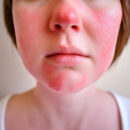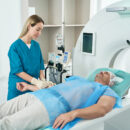Upper Respiratory Tract Infections – What Should Be Considered?

I have a fever! Where is my antibiotic?
Üst solunum yolu enfeksiyonlarının % 80’i virüsler, % 20’si bakteriler tarafından oluşturulur. Yani ancak %20 sinde antibiyotik ihtiyacı vardır. Organizmanın doğal bir savunma mekanizması olan ateş virüslere karşı da oluşturulur. Bu nedenle her ateşli durumda antibiyotik kullanmak doğru değildir. Hemen antibiyotik başlamak ikincil bakteriyel enfeksiyonları önlemediği gibi bu bölgede dirençli bakterilerin yerleşmesine de neden olur. Bu nedenle yapılması gereken ilk şey enfeksiyonun viral – bakteriyel ayrımını yapmak ve etkene uygun tedavi başlamaktır.
The distinction between viral and bacterial is made by producing the microbe or detecting supporting findings through blood tests. Although the findings are similar to each other, there are some differences that help distinguish them.
During the incubation period of viral infections, the person experiences reluctance and resentment. Then, a stinging, burning sensation in the throat and a tickling sensation in the ear begins. While the sore throat subsides within a few days, nasal symptoms become prominent. During this period, which we call the watery period, there is sneezing, watery eyes, white odorless nasal discharge, and usually a mild fever. Muscle aches may occur. Then there is nasal congestion and thick yellow discharge. The disease may continue in this course for two weeks. As long as the findings remain the same, only supportive treatment is given.
Bacterial infections start more acutely. If there is a fever, it will start quickly from the first day. Pain is more intense in the affected area. The wet period is generally short. The nasal discharge is green and, if you pay attention, smelly. In throat infections, the smell becomes more intense, and a thick, dirty, yellow-white rust layer can be noticed on the tongue. There is a higher risk of progression to other areas such as sinusitis, middle ear infection, and bronchitis.
As a result, on average, 80 out of every 100 patients with respiratory tract infections during the autumn and winter months do not need antibiotic treatment. Antibiotics are used only to treat infections caused by bacteria.
So, is it necessary to use antivirals in viral infections?
Antivirals and some other supportive drugs are used only in infections such as Flu (Influenza) and pandemic Coronavirus variant, which develop only in people in the risk group.
Colds (Rhinitis) and flu (Influenza) that develop in people outside the risk group heal spontaneously in 5-7 days. Perhaps the most common diseases for which natural treatment methods alleviate symptoms and provide faster recovery are the common cold (flu) and the flu (influenza), which develops in people outside the risk group. In people diagnosed with cold or flu by a physician, antipyretics, cough suppressants, allergy suppressants, throat lozenges, adequate rest, nutrition and adequate fluid intake, which we call supportive treatment, as well as some natural products can be used.
What are the differences between flu, cold and Covid-19, which are viral infections?
Flu: It is an infectious disease caused by a virus called influenza, which suddenly appears with symptoms such as fever up to 39°, severe joint and muscle pain, fatigue, weakness, chills, head and whole body aches, dry cough, and runny nose. Swine Flu and Bird Flu viruses, which we are familiar with from the pandemics we have experienced in recent years, are subgroups of the Influnza A virus.
It carries a significant risk of contagion during the winter months. The first 72 hours are the most critical period for influenza virus in terms of contagion. Since the immune system in children is less developed than in adults, flu infection can be more severe.
Flu virus (influenza) is transmitted in environments where sick people are present, through droplets after sneezing and coughing (enters the human body through breathing). It is also easily transmitted after shaking hands. Flu is contagious from 2 days before the infection begins to 5 days after the symptoms begin.
Cold (Cold): It is an acute disease that frequently occurs in winter. The common cold is an illness caused by viruses such as coronaviruses, rhinoviruses and RSV. The common cold is milder than the flu. Symptoms do not include muscle and joint pain, but may include mild fever, nasal congestion, change in voice, weakness, and mild sore throat. The most important difference between it and the flu is that a runny nose is present in the common cold, whereas it is usually not observed in the flu. In addition, the cold is a milder disease than the flu. The immune system in the body can easily destroy these viruses and the disease will heal on its own. Supportive treatment is sufficient.
COVID-19 It is a mutated form of the coronavirus, which causes a more severe infection, which causes simple colds. Rather than runny nose and sneezing, high fever, dry cough, joint and muscle pain, weakness and malaise are common symptoms. More rarely, sore throat, headache, loss of smell and taste and diarrhea, and in more advanced cases, respiratory distress and shortness of breath may occur.
We provide early and accurate diagnosis with blood tests performed in our hospital and Covid-19, Influenza A/B, and Group A Streptococcus antigen tests, which are the most common bacterial agent, which give rapid results. We enable our patients to return to their social lives in the fastest and healthiest way with the rational use of medication for the agent. We provide. By preventing unnecessary drug use, we prevent new and negative effects on the patient's metabolism.
We wish you healthy days!
Dr. Mustafa GÜLSOY
Elite Hospital Emergency Service
Contact Us For Appointment:
Telephone line: 0392 444 3548 (ELIT)
Contact Form: https://www.elitenicosia.com/iletisim/

















